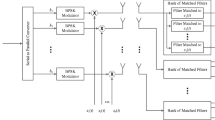Abstract
The use of adaptive antennas in cellular mobileradio systems is considered to be one of the mostimportant measures to increase capacity. The consideredadaptive antenna concept is applied to the well-known TD-CDMA mobile radio air interface. TD-CDMA isadopted by ETSI for the UTRA TDD mode and is one of thecandidates considered by ITU for IMT-2000. In thereceivers of a TD-CDMA system the intracell multiple access interference (MAI) is eliminated byjoint detection. This detection algorithm also offersthe advantageous possibility of considering theintercell interference covariance matrix in order toenhance system performance. In this paper, amulti-antenna receiver structure with the capability toestimate the covariance matrix of the received intercellmultiple access interference (MAI) is presented. The benefits of taking into account theinterference covariance matrix both in channelestimation and data detection are shown by simulations.The directional channel models applied in thesimulations are derived from measured channel impulseresponses.
Similar content being viewed by others
REFERENCES
P. W. Baier, J. J. Blanz, and R. Schmalenberger, Fundamentals of smart antennas for mobile radio applications, Proc. IEEE 8th International Symposium on Personal, Indoor and Mobile Radio Communication s (PIMRC' 97), Helsinki, 1997, pp. 345–376.
A. Papathanassiou, I. Furió, and J. J. Blanz, Link level performance in the uplink of a joint detection CDMA mobile radio system employing multi-antenna array configurations, COST 259 TD (97) 051, Lisbon, 1997.
R. Kohno et al., Combination of an adaptive array antenna and a canceller of interference for direct-sequence spread-spectrum multiple-access systems, IEEE JSAC, Vol. 8, No. 4, 1990, pp. 675–682.
C. Anton-Haro, and J. Fonollosa, Performance evaluation of interference cancellation techniques using adaptive antennas, Proc. IEEE 48th International Vehicular Technology Conference (VTC98), Ottawa, 1998, pp. 1019-1023.
Z. Zvonar, Combined multiuser detection and diversity for wireless CDMA systems, IEEE Transactions on Vehicular Technology, Vol. 43, No. 1, 1990, pp. 205–-211.
P. Jung and J. J. Blanz, Joint detection with coherent receiver antenna diversity in CDMA mobile radio systems, IEEE Transactions on Vehicular Technology, Vol. 44, 1995, pp. 76–-88.
A. Klein and P. W. Baier, Linear unbiased data estimation in mobile radio systems applying CDMA, IEEE Journal on Selected Areas in Communications, Vol. 11, 1993, pp. 1058–1066.
P. Jung and B. Steiner, A joint detection CDMA mobile radio system concept developed within COST 231, Proc. IEEE 45th International Vehicular Technology Conference (VTC' 95), Chicago, 1995, pp. 469–473.
T. Felhauer, P. W. Baier, W. König, and W. Mohr, Optimized wideband system for unbiased mobile radio channel sounding with periodic spread spectrum signals, IEICE Transactions on Communications, vol. E76-B, 1993, pp. 1016–-1029.
R. B. Ertel, P. Cardieri, K. W. Sowerby, T. S. Rappaport, and J. H. Reed, Overview of spatial channel models for antenna array communications systems, IEEE Personal Communications, 1998, pp. 10-–21.
K. I. Pedersen, P. E. Mogensen, and B. H. Fleury, Spatial channel characteristic s in outdoor environments and their impact on BS antenna system performance, Proc. IEEE 48th International Vehicular Technology Conference (VTC98), Ottawa, 1998, pp. 719-–724.
J. Liberti and T. Rappaport, A geometrically based model for lineof-sight multipath radio channels, Proc. IEEE 46th International Vehicular Technology Conference (VTC' 96), Atlanta, 1996, pp. 844–-848.
O. Norklit and J. Bach Andersen, Diffuse channel model and experimental results for array antennas in mobile environments, IEEE Transactions on Antennas and Propagation, 1998, pp. 834-–840.
R. Roy and T. Kailath, ESPRITÐ estimation of signal parameters via rotational invariance techniques, IEEE Trans. Acoust., Speech, Signal Processing, Vol. 37, 1989, pp. 984-–995.
R. Schmalenberger and J. Blanz, Multi antenna C/I balancing in the downlink of digital cellular mobile radio systems, Proc. IEEE 47th Vehicular Technology Conference (VTC' 97), Phoenix, 1997, pp. 607–611.
J. J. Blanz, A. Papathanassiou, M. Haardt, I. Furió, and P. W. Baier, Smart antennas for combined DOA and joint channel estimation in time-slotted CDMA mobile radio systems with joint detection. Submitted for publication in the IEEE Transactions on Vehicular Technology.
M. Weckerle, A. Papathanassiou, and D. Emmer, The benefits of intelligent antenna arrays in TD-CDMA– a study based on measured channel impulse responses, Proc. IEEE 9th International Symposium on Personal, Indoor and Mobile Radio Communications (PIMRC' 98), Boston, 1998, pp. 962-966.
ETSI SMG2#24, WB-TDMA/CDM— System description performance evaluation, Tdoc SMG2 368/97, Cork, 1997.
J. Mayer, J. Schlee, and T. Weber, Realtime feasibility of joint detection CDMA, Proc. 2nd European Personal Mobile Communications Conference (EPMCC' 97), Bonn, 1997, pp. 245-–252.
B. Steiner and P. Jung, Optimum and suboptimum channel estimation for the uplink of CDMA mobile radio systems with joint detection, European Transactions on Telecommunication s and Related Techniques, Vol. 5, 1994, pp. 39-–50.
A. Papathanassiou, M. Haardt, I. Furió, and J. J. Blanz, Multi-user direction of arrival and channel estimation for time-slotted CDMA with joint detection, Proc. IEEE International Conference on Digital Signal Processing (DSP' 97), Santorini, 1997, pp. 375-–378.
M. Weckerle, A. Papathanassiou, and M. Haardt, Estimation and utilization of spatial intercell interference covariance matrices in multi-antenna TD-CDMA systems. Submitted for publication in Proc. IEEE 10th International Symposium on Personal, Indoor and Mobile Radio Communications (PIMRC' 99), Osaka, 1999.
R. W. Lorenz, Zeit-und Frequenzabh ängigkeit der Ñbertragungsfunktion eines Funkkanals bei Mehrwegeausbreitung mit besonderer Berücksichtigung des Mobilfunkkanals, Der Fernmelde-Ingenieur, Vol. 39, No. 4, 1985, pp. 1-–45.
D. Emmer, E. Humburg, P. Weber, and M. Weckerle, Measurements of base station two-branch space and polarization diversity reception and comparison of the diversity gain based on the cdf of signal level and simulations of BER in a GSM system, Proc. IEEE 48th International Vehicular Technology Conference (VTC' 98), Ottawa, 1998, pp. 5-–10.
M. Weckerle, A. Papathanassiou, and R. Schmalenberger, Consideration of the spatial covariance matrix in multi-antenna TDCDMA-systems, COST 259 TD(99)018, Thessaloniki, 1999.
Rights and permissions
About this article
Cite this article
Weckerle, M., Papathanassiou, A. Performance Analysis of Multi-Antenna TD-CDMA Receivers with Estimation and Consideration of the Interference Covariance Matrix. International Journal of Wireless Information Networks 6, 157–170 (1999). https://doi.org/10.1023/A:1018899820985
Issue Date:
DOI: https://doi.org/10.1023/A:1018899820985




